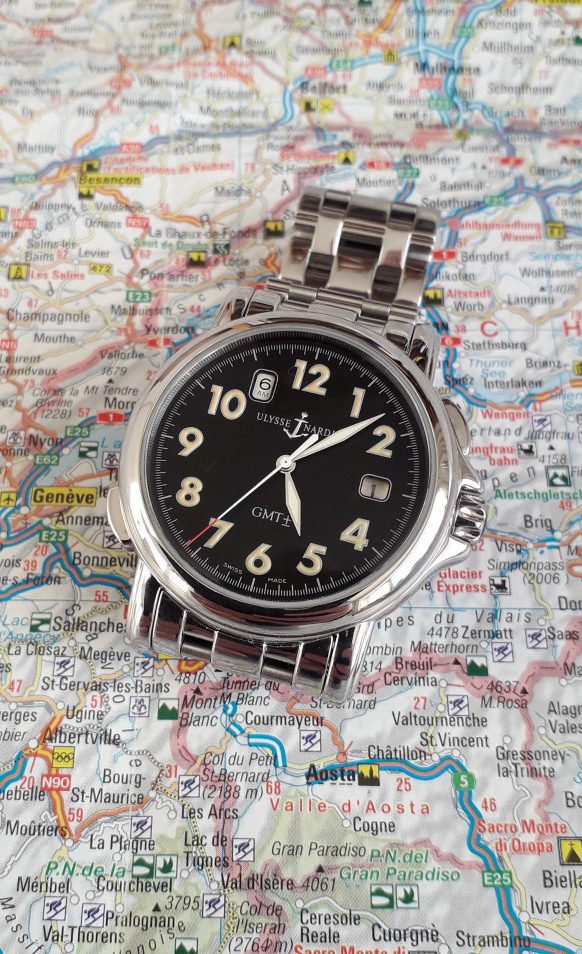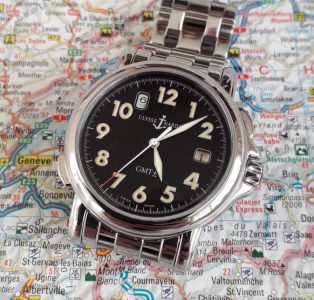Since I disposed of my Rolex GMT 2 some six months ago, I had a nagging feeling that I should have at least one GMT in the cupboard for when life is normalised and I go “foreign” crazy. However, I determined that any replacement would be, well, unusual, a little easier to manipulate and, er, cheaper, so less worry about cossetting it!
Now, before we go further, alert readers may recall that in some or other article not so long ago, I opined that I really must reduce my watch collection, whilst at the same time improving quality. Well, after a degree of procrastination (which can afflict me over certain things), I decided to make a short-list of some of my lesser value and little worn pieces. After a bit of wrestling I came up with seven items. How to sell? Well, that was a little easier in that I knew James (of Kibble Watches) does on occasions buy as well as consign for his e-shop. After having sent him details/images and chatted, the list was whittled down to five he wanted and so a total price was agreed – subject to scrutiny. I was pretty sure there would be no issues as I keep my watches in pretty good shape and most had accompaniments.
It was at this point that I made my usual and fatal error. I decided to have a quick peek at James’s current offerings. One watch that I lingered over and went back to was a Ulysse Nardin San Marco GMT from around the mid-nineties. It was pretty attractive, with a retro “officers” type case shape and military style dial, all on a nicely designed bracelet. Additionally, as it was only a little over £2k it met my non-wallet busting meanness! Although the watch came with it’s box, additional paperwork was frugal. However, as it was in good condition and met other criteria, I decided to invest. Yes, I know, I know, I was supposed to be selling and not buying more. In my defence, the said the watch would be a classy, useful and robust travel companion, plus, I am still down four watches overall and recovered some capital. I can live with all that!
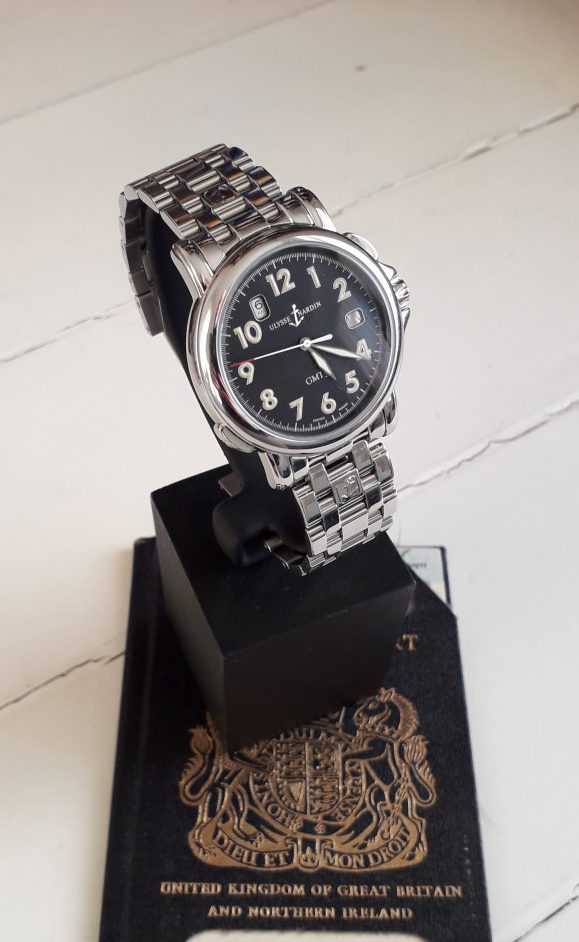
They say that if you do not learn something new everyday then your life is pretty damn miserable or sheltered. As such I make no excuse for admitting that I was not particularly well-versed in UN as a brand. I knew that they were quite old and had a marine heritage, but to be honest I had rather dismissed them as most articles and adverts in recent years had been heavily focused on their Freak models, which personally I am not too keen on. Anyway, after alighting on a brand that I am light on knowledge over, I made it my business to remedy this deficiency.
After having plundered various records it was clear that there was far more to the Company than met the eye – well mine at least. There is far too much information to detail properly here so will just have to summarise somewhat massively! The firm was started in 1846 by one Ulysse Nardin in the Le Locle area of Switzerland. Marine chronometers were the initial speciality, but by 1860 pocket watches and repeaters (to chronometer standard) were being produced. In 1865 the business moved to 3 Rue de Jardin in Le Locle and are in fact still there. In 1876 Ulysse dies prematurely and his son Paul-David takes over. A Gold medal is won in Paris for pocket and deck chronometers. By 1900 pocket chronometers with tourbillon escapements are in production. From 1916 wrist watches are now being produced, and in 1935 a split-second chronograph was offered – used extensively for sporting applications. From then to 1975 much innovation and quality continued. At that time the brand broke 50 years of records at the Neuchatel observatory for chronometer performance. Some 14 Grand prix awards had been garnered by that time. In 1983 Rolf Schnyder was the new owner, and in collaboration with watch maker supremo Dr Ludwig Oechslin, they embarked on a long period of much innovation, specialising in a variety of quality high complication pieces such as the Astrolabium, Tellarium and Planetarium trilogy. The San Marco range was launched in the early nineties and included patented GMT versions – in stainless steel and gold. In 2001 the Freak was launched. With striking looks and colours, this innovative 7 day tourbillon piece had no case as such, or hands, dial or crown, the movement revolving with a pointer to display the time. More artistic finishing was given a major boost in 2012 when dial maker/decorator Donze Cadrans was acquired. Since then many more in-house calibers have been launched and further “modern” pieces such as the Skeleton and more recently the Blast are on offer. All that said the brand does have a range of more conventional and great looking watches covering just about all disciplines and styles. In 2014 the company joined the Kering Group. In 2017 a 5 year warranty was offered. Rolf Schyder died in 2011 and from 2017 Patrick Pruniaux has been at the helm. By all accounts a company with a fascinating history, producing high end quality time pieces.
Righty-ho, now lets get down to business. The watch reference is 213-22-7-52 and is in stainless steel with the round three body case being some 38mm (I say some, as that is what I make it but several old articles offer another couple of measurements but 38 is as near as damn it!). The plain bezel and the main case body is fairly highly polished. The lugs are quite modest with chamfered edges. There is a nicely knurled screw-down crown capped with a recessed blue jewel (possibly enamel or glass) with an anchor flanked by a U and N picked out in metal. The crown is protected by gently tapering guards. At 2 and 8 o’clock are lozenge shaped corrector buttons for the GMT function.
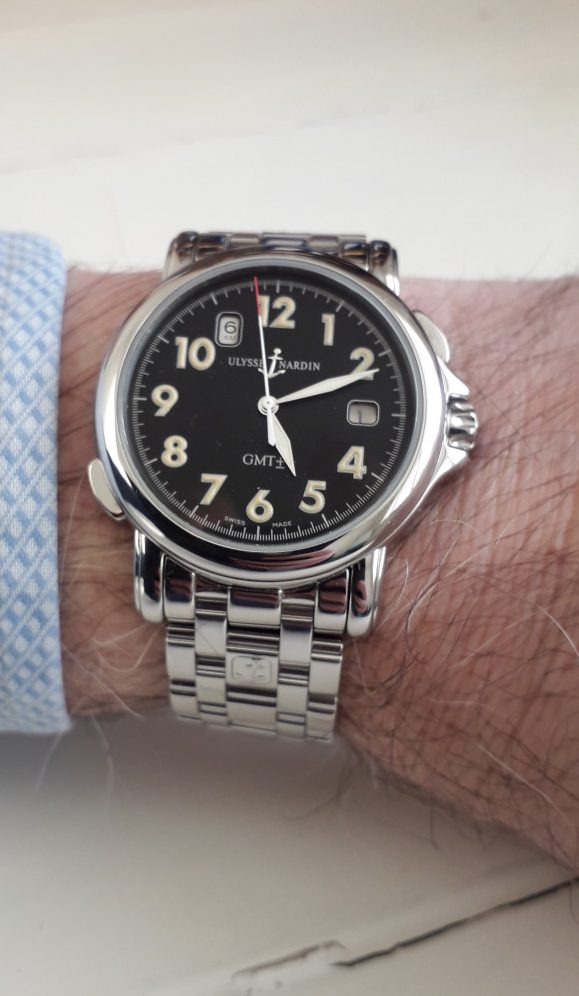
Turning to the dial, as previously mentioned this has an old-school military look. It is black with large arabic numerals and such is the quantity of creamy coloured lume on them, at an angle there is a nice 3d effect. Outboard is a minute track. At 11 o’clock is the GMT second time zone window, which actually supplants the 11 numeral. This cleverly displays the numerals on a white background for diurnal hours and vice versa for nocturnal. At 3 o’clock is a date window with a cyclops type lens. This is required at the date wheel is set somewhat lower than the dial. The hour and minute hands are quite delicate and dauphine or leaf-shaped with lume. The second hand is like a white needle but with a red tip. In terms of dial script, under 12 is the brand name but bisected with a shiny chrome anchor at a jaunty angle. Above 6 is the moniker GMT +/- one over the other. Swiss Made as usual is at the very bottom. All is protected by a sapphire crystal.
Flipping the watch over reveals a solid case back with the San Marco (Venice) human headed winged lion emblem, model number, water resistance to100m and what appears to be a piece number. I am not sure whether this indicates some sort of limited edition, but I will enquire from the brand.
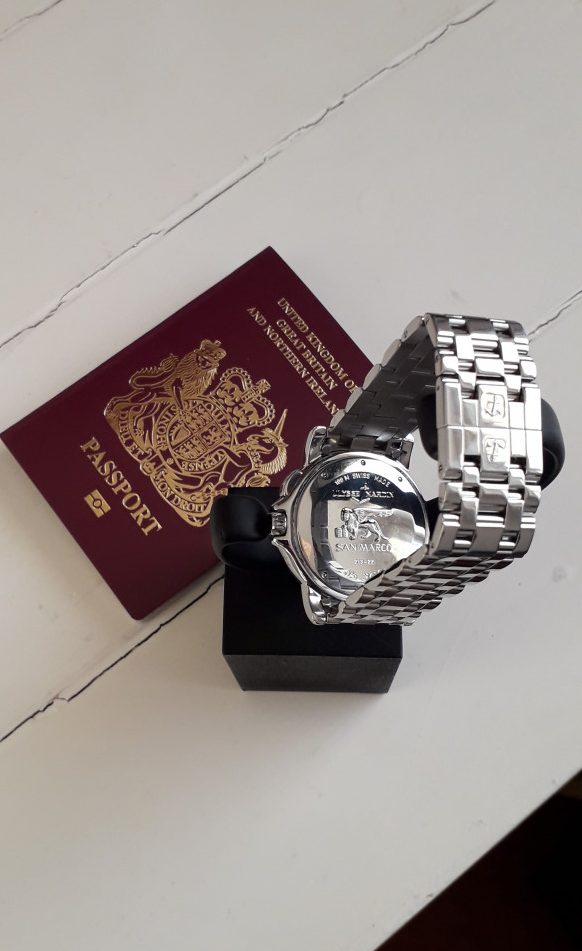
Within the case resides the motive power unit. This is the automatic UN caliber 20, and is in fact based on a modified ETA 2892A2 unit. Components are 143 and jewels 21. Power is laid down at 28,000 vph and the reserve is 48 hours. Other features include an Incabloc anti-shock device, self-compensating Nivarox balance spring, an Etachon regulation system and hacking seconds for precision setting.
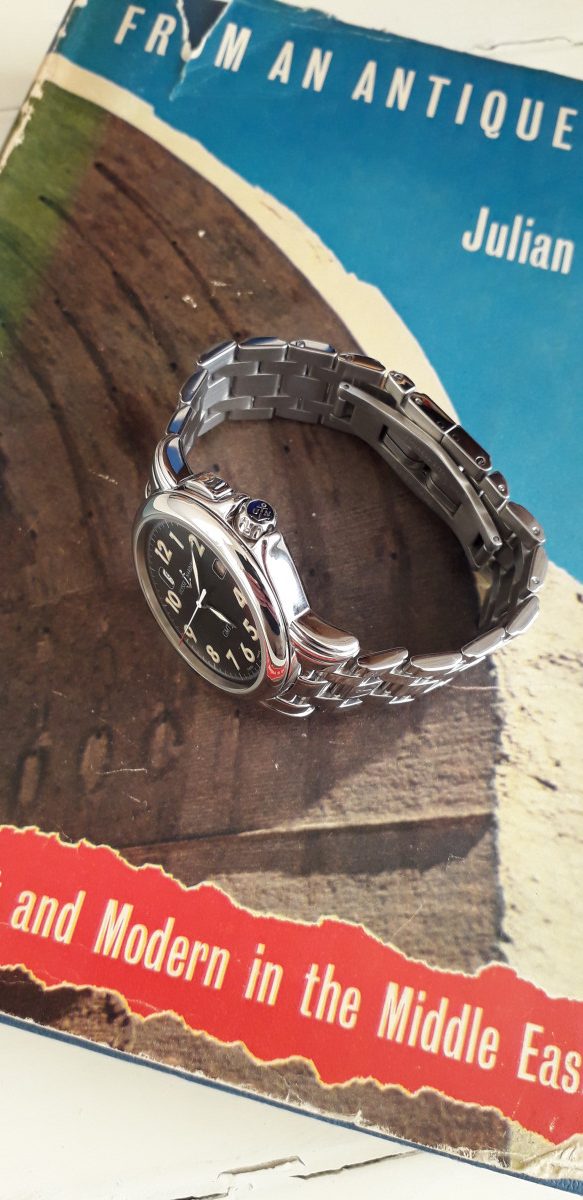
Finally the bracelet. This a really classy piece of work with polished and very flexible links which morph well from the case. Anchor emblems are engraved onto the first main central links. These end at a butterfly clasp with anchors again adorning each end. There is no easy adjustment here, so link work is potentially required. In this case I was fortunate with the fit as the bracelet was one link short of a full complement, but happily with the one spare added it was a perfect fit on my 7.25 inch wrist.
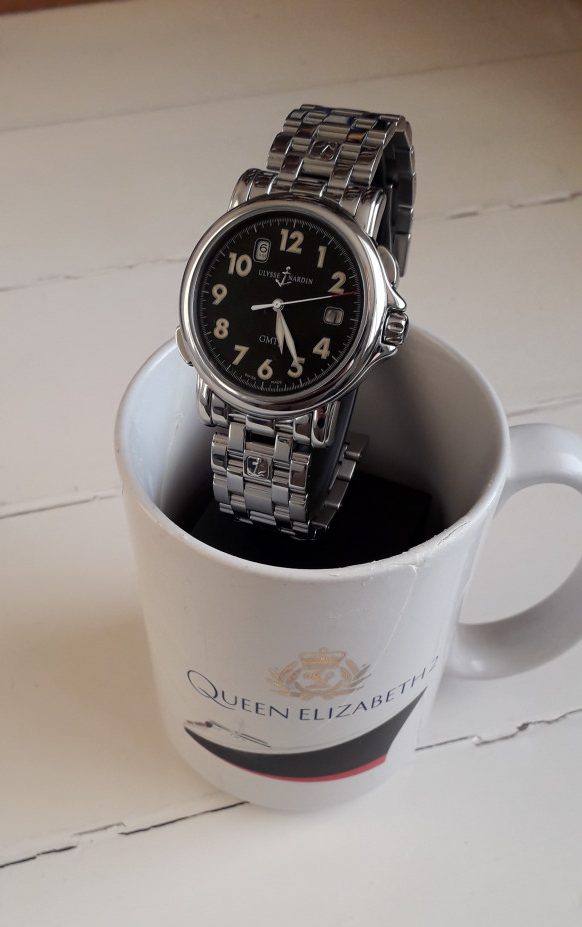
My verdict for the watch is extremely positive. This is a well-made and thoughtfully designed model from a quality manufacture. Information is presented in a clear and attractive fashion, plus functionality is pretty simple. Added to this is the fact that there is a decent movement all within a pretty sturdy structure. All this at a price of say, between £2,500 -£3,000, I feel this represents a good deal today. Incidentally, later versions moved the GMT window to 9 o’clock and the correctors all to the left. Additionally, versions were made with silvered dials and in gold too. The precious metal ones currently seem to go for around £7,000.
Rating: 4.75/5
All images & words The Writer

